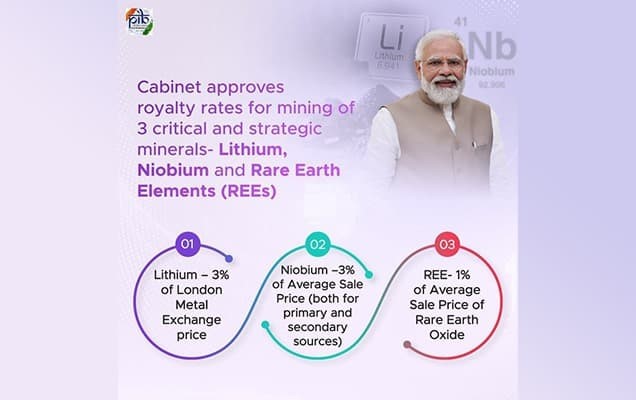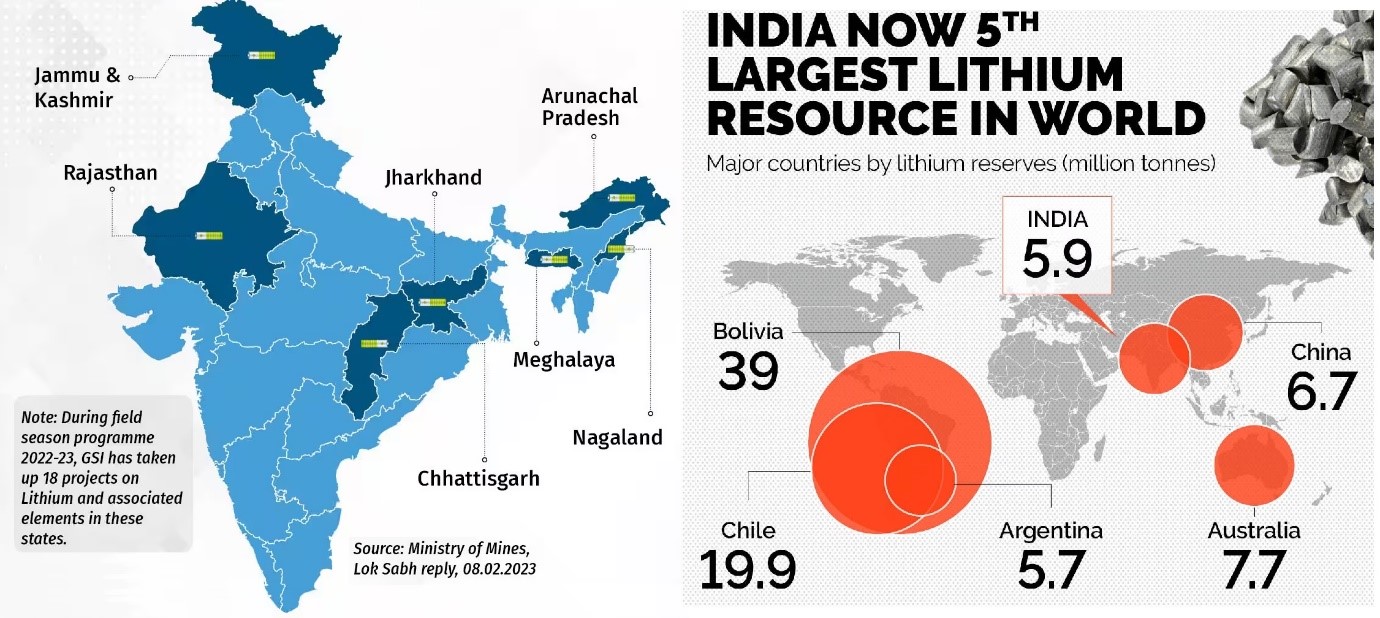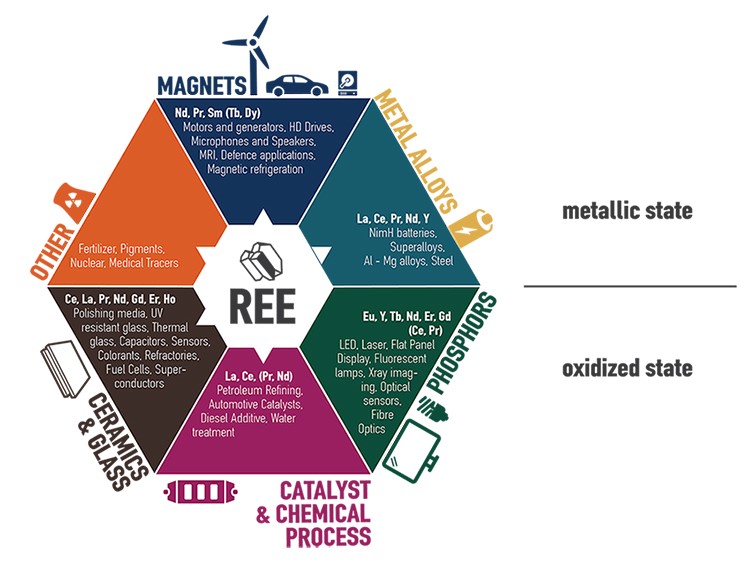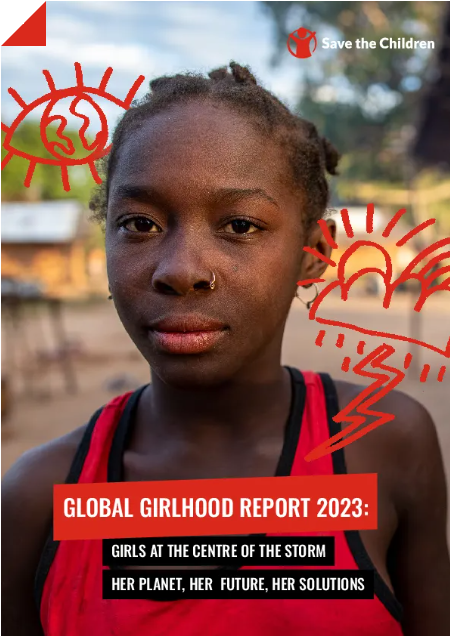1. New royalty rates for strategic minerals
2. Stratospheric Aerosol Intervention Impact on Global Food Production
3. Global Girlhood Report 2023
4. Why electoral bonds scheme has been challenged in Supreme Court?
5. Operation Ajay
6. Gaza Strip
New royalty rates for strategic minerals
Context:
- The Indian government has approved new royalty rates, setting them at 3% for lithium and niobium, and 1% for Rare Earth Elements (REEs).
- These changes are aimed at establishing competitive royalty rates for critical minerals and facilitating private sector involvement through concession auctions.
Understanding Critical Minerals:
- Critical minerals are essential components of modern technologies and are susceptible to disruptions in their supply chains.
- These minerals are crucial in the production of mobile phones, computers, batteries, electric vehicles, and green technologies like solar panels and wind turbines.
- India has identified 22 minerals, including antimony, cobalt, gallium, graphite, lithium, nickel, niobium, and strontium, as critical due to their significance in supporting green technologies, advanced equipment, aviation, and national defense.
Implications of the Amendment:
- Alignment with Global Benchmarks: These amendments align India’s royalty rates with international standards, which is vital for attracting future bidders in mineral auctions.
- Competitive Royalty Rates: The revised royalty rates for lithium, niobium, and REEs, set at 3% and 1% respectively, are more competitive compared to the previous 12% royalty rate for unspecified minerals, enhancing the attractiveness of mining in India.
- Domestic Mining Promotion: Lower royalty rates and commercial opportunities are expected to stimulate domestic mining, reduce imports, and support industries such as electric vehicles (EVs) and energy storage solutions.
- Energy Transition Commitment: Access to critical minerals is fundamental to India’s commitment to an energy transition and its goal of achieving net-zero emissions by 2070, aligning with global environmental objectives.
Economic Significance of the Amendment:
- Lithium
- Reducing Import Dependence: India’s exploration of lithium extraction from regions such as Jammu & Kashmir, Rajasthan, Gujarat, Odisha, and Chhattisgarh aims to reduce reliance on imported lithium, particularly from China.
Economic Strategy: This initiative is part of India’s economic strategy to decrease dependency on China for lithium-ion energy storage products, given China’s dominant position in the market.
- EV Growth: Securing a stable lithium supply chain is essential for India as electric vehicles (EVs) are poised for significant growth in the global market.
Rare Earth Elements
- Addressing Global Supply Challenges: Rare earth elements, often sourced from China, have posed challenges for the EV supply chain. Securing supplies has been a concern, given China’s dominance.
- Importance in Motors: Rare earth elements play a critical role in EV motors, particularly in permanent magnet motors, where elements like neodymium, terbium, and dysprosium enhance motor efficiency.
- Environmental Concerns: Mining rare earth elements has been associated with environmentally damaging open-pit operations, raising environmental and ecological concerns.
- Niobium for Industry
- Corrosion Resistance: Niobium’s corrosion resistance properties make it valuable in various industries, strengthening alloys like stainless steel for applications in aerospace, construction, and pipelines.
- Superconducting Properties: Niobium’s superconducting properties find applications in magnets for particle accelerators and MRI scanners.
- Global Sources: Niobium is primarily sourced from minerals like columbite found in countries such as Canada, Brazil, Australia, and Nigeria.
Conclusion:
India’s decision to amend mining laws for strategic minerals marks a significant step toward international alignment, the promotion of domestic mining, and securing supplies for emerging industries like electric vehicles (EVs) and energy storage.
It demonstrates India’s commitment to a sustainable energy transition, reducing import dependency, and addressing environmental concerns related to mining rare earth elements.
Stratospheric Aerosol Intervention Impact on Global Food Production
Context:
A recent research article featured in the journal Nature Food sheds light on the potential ramifications of a geoengineering approach known as stratospheric aerosol intervention (SAI) concerning global food production.
Key Findings of the Study:
- SAI as a Climate Intervention:
- SAI is viewed as an alternative strategy to address climate change if conventional mitigation measures prove ineffective.
- It emulates the natural cooling effects of volcanic eruptions by injecting sulfur dioxide into the stratosphere (the layer of the atmosphere extending from approximately 10 kilometers to 50 kilometers in altitude).
- This sulfur dioxide oxidizes to create sulfuric acid, eventually forming light-reflecting aerosol particles.
- An example of this phenomenon occurred when Mount Pinatubo in the Philippines erupted in 2001, injecting roughly 15 million tons of sulfur dioxide into the stratosphere, resulting in the formation of aerosol particles.
- According to NASA, this led to a decrease in the average global temperature by about 0.6 degrees Celsius over the following 15 months.
- Varied Impact on Agriculture:
- The temperature reduction due to SAI has diverse effects on agriculture, contingent on factors such as precipitation and solar radiation.
- Understanding the ideal global temperatures for crop production is imperative for making informed decisions.
- Researchers employ computer models to assess the repercussions of SAI scenarios on crops like maize, rice, soybean, and spring wheat.
- In the absence of controlled climate change, crop production thrives in colder, high-latitude areas like Canada and Russia.
- Moderate levels of SAI could potentially enhance food productivity in mid-latitude temperate regions such as North America and Eurasia.
- Under significant climate intervention, tropical regions might experience an increase in agricultural production. These areas include Mexico, Central America, the Caribbean, the upper half of South America, most of Africa, portions of the Middle East, a substantial part of India, Southeast Asia, Australia, and numerous island nations in Oceania.
- Different nations may opt for varying SAI levels to optimize crop production, taking into account their geographical location and climate conditions.
- Comprehensive Impact Assessment:
- Beyond its effects on crop production, the study emphasizes the necessity of exploring other consequences, including its impact on human health and ecosystems.
What is Stratospheric Aerosol Intervention (SAI)?
- SAI is a proposed solar geoengineering method aimed at mitigating global warming. It entails introducing aerosols into the stratosphere to induce a cooling effect, akin to the natural occurrence of volcanic winter.
- However, it’s important to consider that SAI could potentially have unintended consequences for the environment and society, such as affecting the ozone layer, the hydrological cycle, monsoon systems, and crop yields.
What is Geoengineering Technique?
- Geoengineering refers to deliberate large-scale interventions in the Earth’s climate system to combat climate change.
- These interventions typically fall into two categories: Carbon Dioxide Removal (CDR) and Solar Radiation Management (SRM).
Carbon Dioxide Removal (CDR):
- These techniques aim to reduce excess carbon dioxide in the atmosphere, thereby mitigating the greenhouse effect.
- Examples include afforestation and reforestation, biochar, bioenergy with carbon capture and storage (BECCS), and ocean fertilization.
Solar Radiation Management (SRM):
- SRM methods seek to reduce the amount of solar energy reaching the Earth’s surface, ultimately cooling the planet.
Examples comprise Stratospheric Aerosol Intervention (SAI), Space-Based Reflectors (SBR), Marine Cloud Brightening (MCB), Cirrus Cloud Thinning (CCT), and Surface Albedo Modification (SAM).
Global Girlhood Report 2023
Context:
In a context related to the International Day for Girl Child on October 11th, Save the Children International unveiled the Global Girlhood Report.
The report’s key findings are as follows:
- Climate-Related Child Marriage Risk:
- Save the Children’s report indicates that nearly 9 million girls around the world are exposed to an elevated risk of child marriage due to climate-related disasters.
- This risk is particularly pronounced in regions with above-average climate hazards, as revealed in the 2023 Global Girlhood Report.
- Furthermore, the report forecasts that the number of girls facing the dual threats of extreme weather events and child marriage is expected to increase in the future.
- Top 10 Hotspot Countries:
- Currently, approximately 29.9 million girls reside in the top 10 countries identified as both child-marriage and climate hotspots.
- These nations include the Central African Republic, Chad, Guinea, Bangladesh, Burkina Faso, Malawi, Mali, Mozambique, Niger, and South Sudan.
- By 2030, this number is projected to rise by 2.3 million to 32.2 million, with a one-third increase estimated by 2050.
- Regional Impact:
- The most severely affected regions by child marriage and the climate crisis are South Asia (with Bangladesh as a key example) and sub-Saharan Africa (including the Central African Republic, Chad, and Guinea).
- These areas also grapple with issues such as poverty, gender inequality, conflict, and hunger.
- Impact of Climate on Child Marriage:
- Historical data analysis reveals that a 10% increase or decrease in rainfall is correlated with a corresponding change in child marriage rates globally.
- For instance, drought-affected areas in Ethiopia witnessed a 119% increase in child marriage rates in 2022 compared to 2021.
- Extreme heat in Bangladesh doubled the likelihood of girls aged 11-14 getting married in the years following such events.
- Severe flooding in Niger in 2022 affected over 2.6 million students and significantly increased the risk of child marriage, particularly for girls.
- Following Cyclone Freddy, Malawi observed a surge in child marriages in the first half of 2023.
- Urgent Need for Action:
- Girls facing the impact of child marriage and climate-related challenges are less likely to complete their education, have an increased risk of experiencing violence, and face greater health risks during pregnancy and childbirth.
- Worryingly, less than 2% of national climate plans globally explicitly consider the needs of girls.
- Proposed Solutions:
- The report underscores the urgent need to address the climate crisis as a girls’ rights emergency.
- It suggests three approaches to address the specific effects of the climate crisis on girls and advance gender equality as a part of climate action.
- These include making gender equality and protection from gender-based violence central priorities in climate action, investing in anticipatory measures to safeguard the systems and services girls require, and supporting girls as decision-makers and participants in autonomous feminist movements.
- The report advocates for investment in climate change adaptation, with a particular focus on highly vulnerable children, especially girls.
Regarding the International Day for Girl Child in 2023:
- The theme for the day is “Invest in Girls’ Rights: Our Leadership, Our Well-being.”
- The International Day of the Girl Child, established by the United Nations (UN), is observed annually on October 11th. It was first celebrated in 2012.
- On December 19, 2011, the UN General Assembly passed a resolution designating October 11th as the International Day of the Girl Child.
- This day is dedicated to raising awareness about gender equality, advocating for girls’ rights, and improving opportunities for their well-being.
Additionally, the Ministry of Women & Child Development celebrated the National Girl Child Day on January 24, 2023, with the theme “Digital Generation, Our Generation.”
Why electoral bonds scheme has been challenged in Supreme Court?
Context:
- In the latest legal development, the Supreme Court has fixed a hearing for October 31, addressing a series of petitions challenging the government’s electoral bonds scheme.
- These petitions raise significant concerns about the legitimacy of the scheme as a means of financing political parties.
Introduction to the Electoral Bond Scheme
- The electoral bond scheme, introduced in the 2017 Finance Bill, was formally implemented by the government on January 2, 2018, with the primary objective of enhancing transparency in political funding.
Understanding Electoral Bonds
- Electoral bonds, which function as bearer instruments, can be acquired by individuals or entities to contribute funds to political parties.
- They are available in multiple denominations and can be purchased at specific State Bank of India (SBI) branches.
- These bonds are akin to cash and are interest-free, with specific purchase periods during the year.
Challenges to the Electoral Bond Scheme
- The electoral bond scheme has faced legal challenges primarily due to concerns about its legitimacy and transparency.
- Critics, including NGOs and political parties, have voiced their concerns and objections to various aspects of the scheme.
Amendments and Unlimited Funding
- One significant concern revolves around amendments in the Companies Act, which removed donation limits for companies, thereby allowing unrestricted political contributions.
- These amendments were enacted to facilitate the use of electoral bonds as a means of anonymous political donations.
Transparency Concerns
- Despite the requirement for bank transfers when purchasing electoral bonds, the scheme has faced criticism for obscuring the identity of donors, making it challenging to trace the source of contributions.
The debate over transparency continues, with the government maintaining that the State Bank of India has access to funding information.
Operation Ajay
Evacuation Operation ‘Ajay’
- In recent developments, the Union Ministry of External Affairs has undertaken ‘Operation Ajay’ with the objective of evacuating Indian citizens from the conflict zone, amidst the ongoing clashes between the Israeli Defense Forces (IDF) and Hamas in Israel.
- The nation has been facing an unprecedented attack by the Hamas militant group, which governs the Gaza Strip.
Operation Ajay: Rescuing Stranded Indians
- Under the banner of ‘Operation Ajay,’ India has declared its commitment to assist Indian citizens stranded in Israel in returning home, as fresh tensions erupted in the region due to a series of bold attacks on Israeli towns by Hamas militants over the weekend.
- According to information from the external affairs ministry, there are currently approximately 18,000 Indian residents in Israel.
Hamas: A Profile
- Hamas, established in 1987, is a Palestinian Islamist political organization and militant group with the primary objective of establishing an Islamic state in Palestine.
- It is worth noting that various countries, including the United States, Canada, and the European Union, have classified Hamas as a terrorist organization.
Hamas has been involved in numerous attacks on both Israeli civilians and military targets, including suicide bombings, rocket assaults, and kidnappings.
Gaza Strip
Geographical Location: The Gaza Strip is positioned along the eastern coast of the Mediterranean Sea.
Political Borders: The Gaza Strip shares its boundaries with Israel to the north and east, while its southern border is with Egypt.
Historical Context:
- Following Israel’s declaration of statehood in 1948, the Gaza Strip was under the administration of Egypt for approximately two decades.
- In 1967, during the Six-Day War, Israel took control of the Gaza Strip.
- In 2005, Israel evacuated approximately 9,000 Israeli settlers and its military presence from the Gaza Strip, leading to its governance by the internationally recognized Palestinian Authority.
Current Administration:
Presently, the Gaza Strip is under the governance of Hamas, a Palestinian Islamic organization that took control in 2007 after winning democratic elections. It should be noted that Hamas does not acknowledge Israel’s right to exist.
Blockade: Since 2007, Gaza has been subjected to a comprehensive land, air, and sea blockade imposed by Israel.








